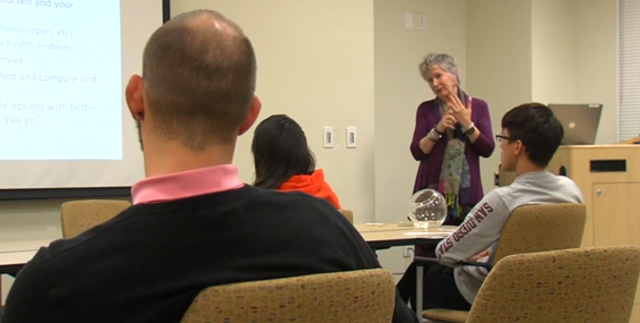“You don’t get a phone on your own, you don’t get an apartment on your own, you don’t buy a car on your own if your credit’s messed up,” she told the students.
Encouraging healthy young adults to buy health insurance is essential to the success of the Affordable Care Act. That's because, on average, the premiums older adults pay don’t fully cover all of their medical expenses.
On the other hand, the premiums that young adults pay tend to more than cover their expenses. For the system to work, more young adults need to be enrolled. But for many of them, like graduate student Charlie Griggs, who attended the presentation, health insurance just isn't a top priority.
“I mean, school’s a pretty big responsibility," Griggs explained. "And moving from doing homework to trying to take care of the health insurance, well, it’s easy to put that on the back burner.”
Spencley said students are a tough sell. They think they’re invincible.
“And I don’t think they realize that you’re healthy until you’re not. And that’s not the time to get coverage," Spencely said. "Or if you have any kind of an active lifestyle, including getting up and walking across the street, riding your bike, riding your skateboard, surfing, going up and down stairs, something can happen.”
Students in the Cal State system are not required to have health insurance. But at San Diego State, students must pay a health fee of $175 per semester.
That gives them access to a full array of primary care services at the student health center, including radiology and prescription drugs, all at little or no cost.
But SDSU social worker Irma Murphy said there’s a catch: the center is not open around the clock.
"So they’re not going to be able to see someone if they’re sick in the middle of night," Murphy explained. "They’ll have to go to an off-campus urgent care center, or emergency, and we don’t offer that. We don’t have urgent care, either.”
If they're not insured, students would then have to pay for that care.
In Covered California’s first year of operation, more than 400,000 people ages 18 to 34 bought an insurance plan. Young adults represented 29 percent of all enrollees.
Enrollment of young adults exceeded projections. And health exchange officials want to keep that kind of mix going.
Trolling for Students
Near the SDSU Student Union building, Brittnie Bloom handed out information about Covered California.
Thanks to a Covered California grant, campus coordinators like Bloom are on site at 12 of the largest Cal State schools.
Bloom said it’s hard for students to see the value of buying insurance.
“Especially when you are young, and think that you can rule the world, and nothing will happen," Bloom said.
Bloom and her fellow coordinator, Kim Benzie, make presentations all over campus.
But they don’t usually draw much of a crowd. Still, if only one person shows up, they’ll go through their spiel.
They also pitch Covered California in classrooms, where they’re guaranteed to have at least a few students in the audience.
Bloom likes to mention the cost of monthly premiums.
“So how much is it?" she asked the class. "Depending on your income, depending on the plan you would like, it can be as low as $26, which is less expensive than many of our cellphone bills; a hot date to the movies.”
This presentation at a Chicano studies class hit home. By the end, seven students said they wanted information about signing up.
Cal State officials estimate that 10 percent of its students have no health insurance.
